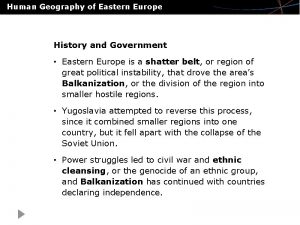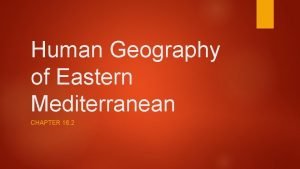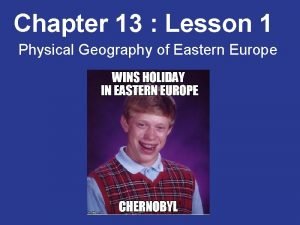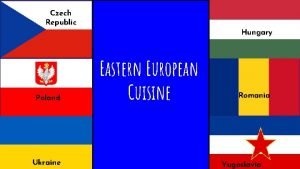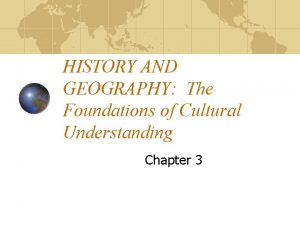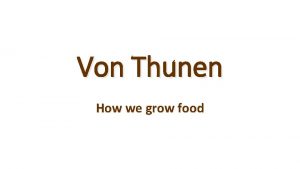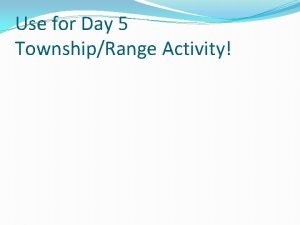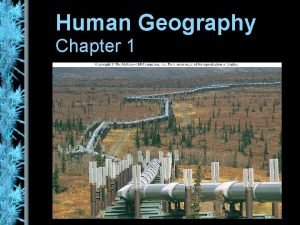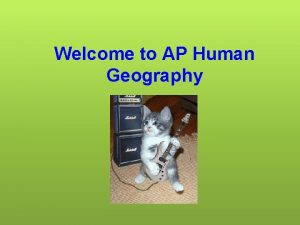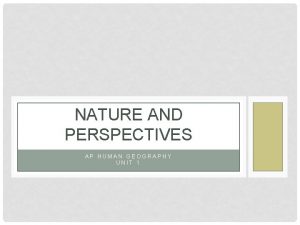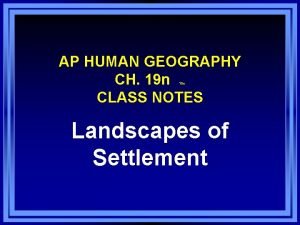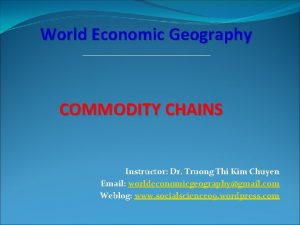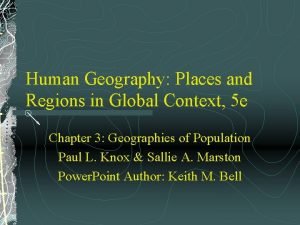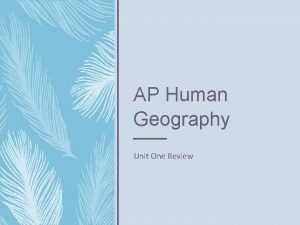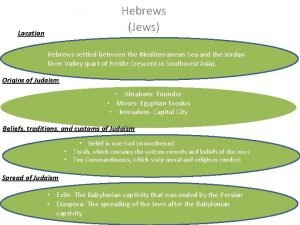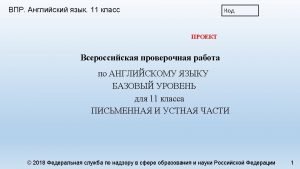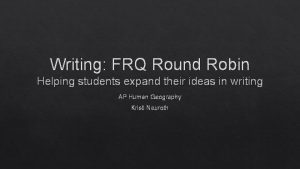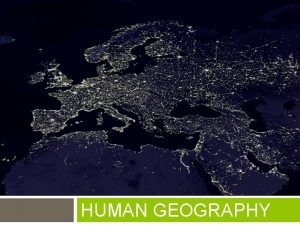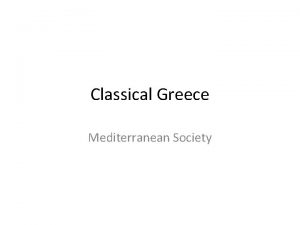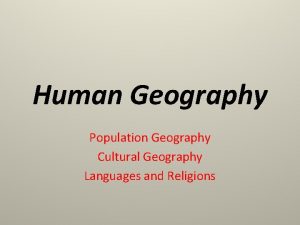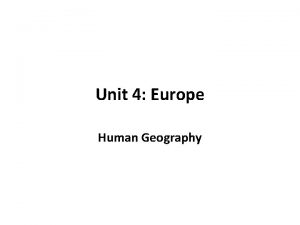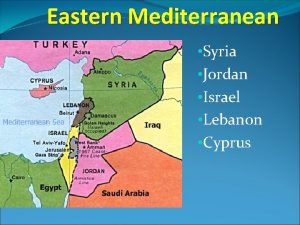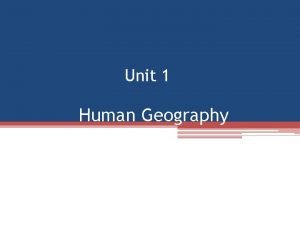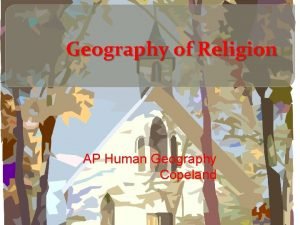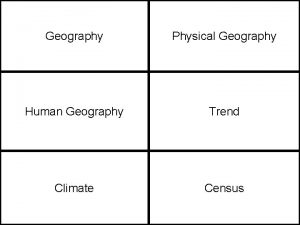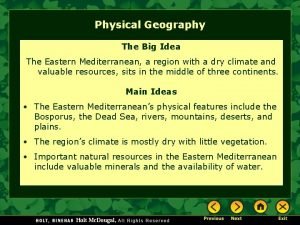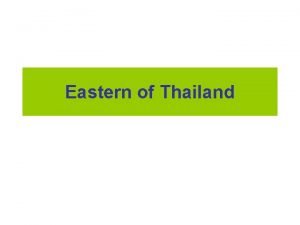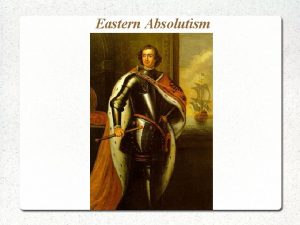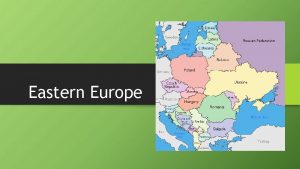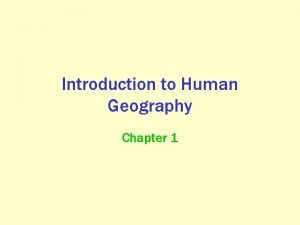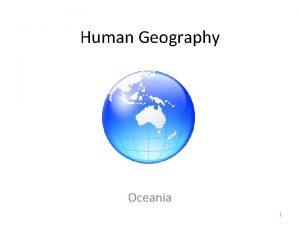HUMAN GEOGRAPHY Eastern Mediterranean EASTERN MEDITERRANEAN HISTORY AND





























- Slides: 29

HUMAN GEOGRAPHY Eastern Mediterranean

EASTERN MEDITERRANEAN HISTORY AND GOVERNMENT • The area is the birthplace of three major religions: Judaism, Christianity, and Islam. • Following World War II, armed conflicts broke out among Jewish and Arab groups in Palestine. • The Jews accepted a 1947 United Nations plan to divide Palestine into a Jewish state and an Arab state, while the Arabs rejected it. • Since 1948, tensions have riled both sides. • Other countries in the subregion have also struggled since independence.


POPULATION PATTERNS • The dry, desert climate causes most people to live along the coastal plains. • Many ethnicities and religious sects reside in the subregion. • Demographics have changed drastically in the past century, with Israel experiencing a large migration of Russian Jews and the displacement of Palestinians following the establishment of the Israeli state.

SOCIETY AND CULTURE AND TODAY • Arabic is the primary language in the subregion. • Hebrew also spoken in Israel.

SOCIETY AND CULTURE AND TODAY • Quality of education and health care varies widely from country to country. • Family life usually includes the extended family and often includes religious worship. • In Israel, women generally enjoy equal rights, while in Arabic countries, women’s rights vary greatly.

ECONOMIC ACTIVITIES • Economic growth is dependent on agriculture, small deposits of minerals, and manufacturing. • Service industries play a significant role in the subregion’s economy, as does tourism, although it can be negatively affected by conflicts and political instability. • Water transportation is vital to the area, with the Strait of Tirān linking the Gulf of Aqaba to the Red Sea.

HUMAN GEOGRAPHY Northeast

HISTORY AND GOVERNMENT • The rich alluvial soils of Mesopotamia supported the development of agriculture, enabling it to become a culture hearth , or a center where rich cultures develop and spread to other areas.

HISTORY AND GOVERNMENT • The Persian qanat, or underground canals used for irrigation.

HISTORY AND GOVERNMENT • Cuneiform, a form of early writing invented by the Sumerians, show the achievements of early civilizations. • Why do you think writing needed? • Turkey is working toward membership in the EU, while Iraq and Iran have struggled with political turmoil in recent decades.

POPULATION PATTERNS • While Islam is the dominant religion and significantly influences the culture, the population is ethnically diverse. • Major ethnic groups include Turks, Iranians, Arabs, and Kurds. • The Kurds are an ethnic group without an official country, although they call the area in which they live Kurdistan. • Countries in the subregion are increasingly urban, with overcrowding common in cities.

SOCIETY AND CULTURE TODAY • Languages and customs differ depending on ancestral homes. • Family life includes the extended family. • In more secular societies such as Iraq, women and men have equal rights under the law, while women’s rights have been curtailed in Iran. • Early civilizations created important pieces of art and architecture, with Iran still the epicenter for the production of world-famous Persian rugs. https: //www. cnn. com/2017/09/27/middlee ast/saudi-women-still-cant-dothis/index. html

WOMEN IN IRAN: HOW ARE WOMEN'S ROLES CHANGING?

ECONOMIC ACTIVITIES • Oil is a major economic resource in Iran and Iraq, allowing them to exert considerable influence in global affairs. • Natural gas, fishing, and agriculture also play important roles in the subregion’s economy. • Interdependence and trade are necessary in the area, as the countries of the Northeast need industrial products for their own markets, while industrialized countries need oil.


HUMAN GEOGRAPHY Arabian Peninsula

HISTORY AND GOVERNMENT • • • Religion, ethnicity, and shared culture define the region, with most people being ethnic Arabs who practice Islam. For centuries, tribal groups based on family relationships, or sheikdoms, controlled specific areas of the subregion, and their influence continues. The majority of governments in the area are monarchies, with Saudi Arabia, Oman, and Qatar being absolute monarchies.

POPULATION PATTERNS • • • The dry, desert climate causes most people to live along the coasts of the Persian Gulf and Red Sea. Migration of workers to oil and construction jobs has altered the once exclusively Arab population. In the interior of Saudi Arabia lies Makkah (Mecca), the holiest city of Islam, Madinah (Medina), which houses the tomb of the prophet Muhammad, and Riyadh, an important oil refining center and the capital.

SOCIETY AND CULTURE TODAY • Arabic is the primary language in the subregion, with English the most common second language. • After Muhammad’s death, conflicts arose over who would be the rightful successor, breaking the religion into different sects. • Shari’ah, or Islamic law, governs every aspect of a Muslim’s life. • Most countries do not enforce equal rights for women, and women have little political power.

ECONOMIC ACTIVITIES • Oil has produced great wealth for the Arabian Peninsula; it is one of the world’s most important regions for oil production. • Countries with smaller oil reserves have developed other industries, such as banking and finance in Bahrain, and fishing in Oman, to foster economic growth. • Lack of water remains the most important natural resource issue.

GEOGRAPHY NOW GO: SAUDI ARABIA

HUMAN GEOGRAPHY Central Asia

HISTORY AND GOVERNMENT • Christianity has been a significant influence in Armenia and Georgia, while Islam became the predominant religion of the “stan” countries. • Established for trade between Europe and China, the Silk Road became an important asset and target for various empires.

HISTORY AND GOVERNMENT • • The entire region, except Afghanistan, was under Soviet control until the 1990 s. Ethnic conflict and political turmoil continue to plague the region.

POPULATION PATTERNS • Although several countries are named for one ethnic group, most have a complex mix of ethnic groups. • Populations are shrinking in Armenia and Georgia due to low birth rates, while the populations of other nations are increasing. • The rate of urbanization is low overall but growing. • Ethnic differences have created conflict in some areas resulting in displaced persons.

SOCIETY AND CULTURE TODAY • Languages in the Turkic language family are the most commonly spoken, though Russian is still widely used. • Literacy rates are high except in Afghanistan, and health care spending overall is low, except in Georgia. • Family life is a mix of traditional and modern influences, depending on rural or urban location. • Under Soviet control, women enjoyed more equal rights than in many countries, especially Afghanistan.

ECONOMIC ACTIVITIES • Economic growth is dependent on agriculture and exports of natural resources, such as oil and natural gas. • Economic output remains low, as many people rely on agriculture, but farming methods and lack of arable land constraint yields. • Most countries have not yet shifted to market economies, leaving governments in control of many facets of manufacturing and farming, resulting in inefficient business practices that are also susceptible to corruption.

 Human geography of eastern europe
Human geography of eastern europe Chapter 16 eastern mediterranean answers
Chapter 16 eastern mediterranean answers Ap human geography political geography frq
Ap human geography political geography frq 5 themes of geography ap human geography
5 themes of geography ap human geography Ap human geography political geography test
Ap human geography political geography test Human development index definition ap human geography
Human development index definition ap human geography Chapter 13 lesson 1 physical geography of eastern europe
Chapter 13 lesson 1 physical geography of eastern europe Fertile crescent ap human geography definition
Fertile crescent ap human geography definition Is poland considered eastern europe
Is poland considered eastern europe World history final exam study guide
World history final exam study guide History and geography the foundations of culture
History and geography the foundations of culture Rectangular survey system ap human geography
Rectangular survey system ap human geography Township and range ap human geography
Township and range ap human geography Relative location
Relative location Township and range definition ap human geography
Township and range definition ap human geography Unit 1 ap human geography
Unit 1 ap human geography Long lot definition ap human geography
Long lot definition ap human geography Commodity chain ap human geography definition
Commodity chain ap human geography definition Human geography places and regions in global context
Human geography places and regions in global context Exclave ap human geography definition
Exclave ap human geography definition Dispersed definition ap human geography
Dispersed definition ap human geography Habit ap human geography
Habit ap human geography The hebrews settled between the mediterranean sea and the
The hebrews settled between the mediterranean sea and the Human history becomes more and more a race
Human history becomes more and more a race Chapter 8 human needs and human development
Chapter 8 human needs and human development Chapter 8 human needs and human development
Chapter 8 human needs and human development Non human nouns
Non human nouns These are photos from your photo album впр
These are photos from your photo album впр Big geography definition ap world history
Big geography definition ap world history Brownfields ap human geography
Brownfields ap human geography
